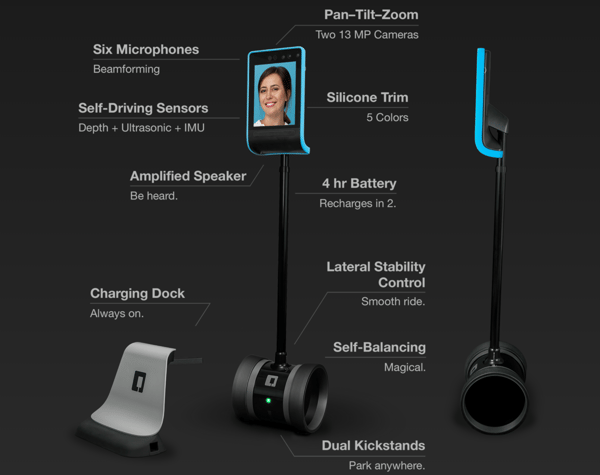Have you ever wished you could be in two places at once?
While we’re nowhere near creating clones to go do our laundry for us, roboticists are getting closer and closer to delivering an experience that is the next best thing! With the advent of cloud computing and the many strides made in AR and VR over the past decade, it’s now easier than ever to send and receive live video data over vast distances. This combined with material mobility of remote controlled robots has made what were once considered dreams a reality. With the advancements in technology it’s now possible to transform the transmission of video and audio data into a facsimile of the tactile expression of a human’s influence on their surroundings.
What is a telepresence robot?
A telepresence robot is a machine that allows a virtual version of yourself to exist and interact with the world in place of you physically being there — like in James Cameron’s movie Avatar — a blurred line of augmented reality that is generally referred to as a “telepresence”, in the sense that your presence is being “telephoned” in.
How much does a telepresence robot cost?
Telepresence robots can take a variety of forms, some mobile and others not. Currently, some of the high-end telepresence robots with the most advanced features can run up to $4,000.
Generally, these machines are controlled remotely by a tablet, computer, or smart-phone and include video cameras, microphones and speakers for voice communication, and some form of mobility device that allows the user to move the robot about their environment.
This is based on a fusion between video-calling software such as Skype or Zoom, however, it takes these principles one step further. It fuses the ability to see and hear with a rudimentary ability to interact with the environment. This has the added benefit of giving the user complete control over how they interact with the environment they are virtually visiting.
How do telepresence robots work?
There are a few different configurations of telepresence robots. They range from simple mounts for a tablet to fully automated machines that can even drive themselves to specific locations without even needing a remote pilot.
 Example of a high-end telepresence robot courtesy of Double Robotics
Example of a high-end telepresence robot courtesy of Double Robotics
Of course, with more features comes a heftier price tag.his isn’t to say a barebones telepresence robot couldn’t revolutionize your work-life balance. These robots work by either following predetermined paths, using joysticks and traditional controls, or even using 3-D space recognition to allow for a click-and-point movement functionality.
How are telepresence robots being used?
Telepresence robots are used to provide a far-reaching presence for people who need to assert themselves in more than one physical space. Usually, this is done to reduce the cost and hassle of having to travel for work related engagements while not having to rely on cumbersome scheduling that come with traditional video meetings. Having the ability to interact on your terms is something you don’t realize you need until it’s gone.
Example of how telepresence robots could be used in education
More specifically, telepresence robots are becoming much more commonplace in certain industries where spreading manpower can be critical for success. In medicine, doctors have started to adopt telepresence robots as a way to help monitor patients with delicate health or in the process of recovery. Often, these robots allow the doctor to prognosticate any complications and come equipped with medical capabilities alongside the normal telepresence package.
Roll out
Now that you know the ins and outs of telepresence robots, you should consider the ways in which blending augmented reality and robotics could benefit not only your business, but your personal life as well. Reducing the commitments of travel can go a long ways towards freeing up time and energy for some of the things that really matter
If you're looking for more ways to enhance your perceptions and the world around you, be sure to check out our content on Mixed Reality!
 by Piper Thomson
by Piper Thomson
 by Piper Thomson
by Piper Thomson
.png) by Tanuja Bahirat
by Tanuja Bahirat